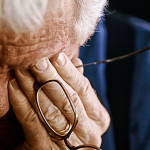When interacting with someone who is blind or visually impaired
- When asking someone with a vision problem if they need help; don’t assume they do. If they do, they will tell you how to help.
- If you live or work with someone who is blind or visually impaired, please do not leave doors ajar.
- Please put things back in the place you found them (i.e., kitchen utensils, etc.)
- Be sure to discuss furniture placement changes before making them.
- Always talk directly to people who are blind or visually impaired, not through their companions.
- When talking to a person who is blind or visually impaired, don’t yell!
- Identify yourself when entering a room if a person with a vision loss is present. Don’t play guessing games to see if he/she knows who you are.
- Give directions as clearly as possible. Remember not to point.
- Remember that a guide dog is a working dog, not a pet.
DO NOT PET THE DOG! It diverts the dog’s attention.
- Offer to read the menu and prices when eating out. Ask what assistance is needed.
- Look at people who are blind or visually impaired as individuals with interests and needs similar to your own.
- Do not hesitate to use the words “blind” and “see” when talking to a person who is blind or visually impaired.
White Canes
- White Canes are provided to individuals diagnosed as Legally Blind. Legal blindness doesn’t mean total vision loss. In fact, according to the American Federation for the Blind, 85% of all individuals with eye disorders have some remaining sight. Many of these individuals may qualify for a White Cane.
- White Canes provide pedestrian identification. They are essential for safe mobility, assisting the user with identification of walls, steps and curbs.
- In 1932, the White Cane was “born” in Michigan in the East Side Detroit Lions Club. In 1936, Michigan passed the White Cane Law. An excerpt from the Michigan Drivers Manual:
Blind Pedestrians
Michigan law requires you to stop or yield the right-of-way when you see a pedestrian with a white cane or guide dog. Only the blind may carry white canes. Avoid honking the horn or revving the engine; these noises are distracting and cover important audible cues used by the blind. Also avoid blocking designated crosswalks. This makes it especially difficult for a visually impaired or blind person to cross the street. It is also an inconvenience for others attempting to cross and violates the rule of always yielding to pedestrians.
- ABVI teaches Orientation and Mobility to individuals using a White Cane. We also help each individual with the proper selection of a White Cane for their personal needs. Canes differ in length, style and the type of “tip” used for guidance.
General
- Proper lighting is a must for all visual tasks.
- Using contrasting colors can help you distinguish one object from another. (Example: Dark tablecloth with white plates.)
- Continue to see your eye doctor even after vision loss to help prevent future problems.
- Ask your eye doctor to clearly explain and write down your eye condition, including your acuity and field of vision. This information will be useful when pursuing rehabilitation services.
Low Vision Tips
- A pocket magnifier can help you to read labels or a menu.
- A lighted magnifier gives better contrast for reading.
- Wearing a visor or a hat with a brim can minimize glare.
Orientation and Mobility
- Plan your route thoroughly before starting out; use landmarks and reference points.
- Mark the edges of the steps with a bright color to improve visibility.
- Take the arm of a sighted person assisting you; rather than letting him/her push you. The motion of his/her body will tell you what to do.
Independent Living
- Bold-lined writing paper will help you stay on line while writing.
- Purchase large print checks that are available at banks. Use a check writing guide made to fit over your checks. Write with a black gel pen for easier reading.
- Phone numbers or recipes can be written in Large Print or recorded for easy access.
- Identify medications with a pill organizer.
- Place entire outfits together on one hanger if color identification is a problem.
- Mark your appliance controls with bright colored tactile buttons (stick-ons).
- Make sure your rugs are safely secured so you don’t trip over or slide on them
- Use bright lights (but avoid fluorescent) in your home for better vision contrast
Coping with Helplessness and Fear
- Feelings of helplessness and fear are common. Talking with family, friends or a social worker will help.
- Let others know what your needs are; don’t assume they know. You may have to find the balance between independence and asking for assistance. This is normal and natural.
- Don’t give up! There ARE alternative ways to accomplish tasks independently. Remember that you have experienced, in your lifetime, other challenges and have been able to rise to accomplish issues that seemed impossible.

